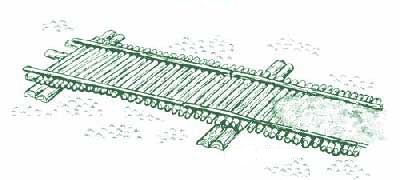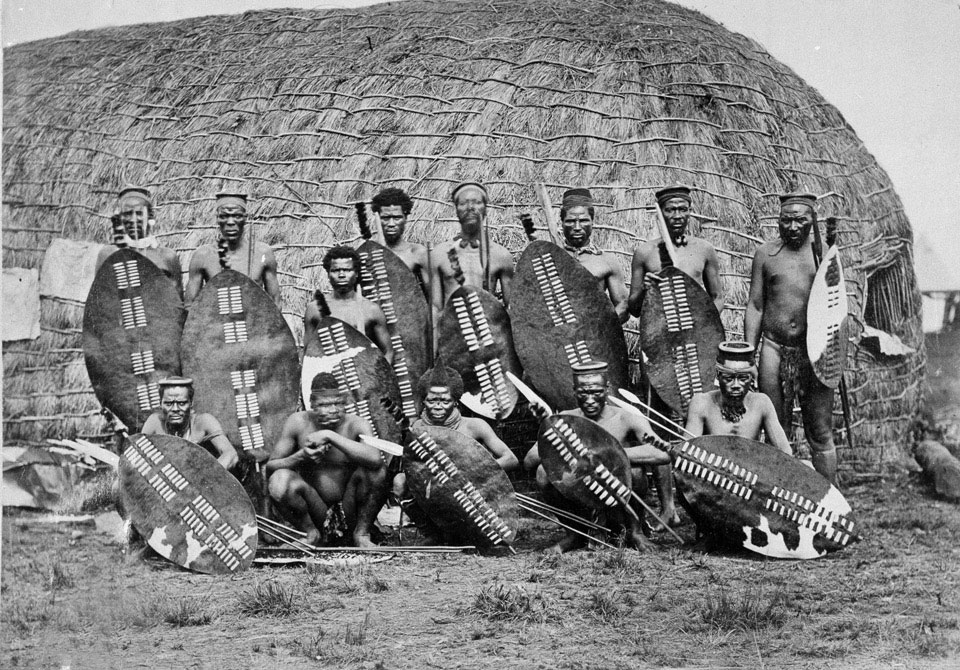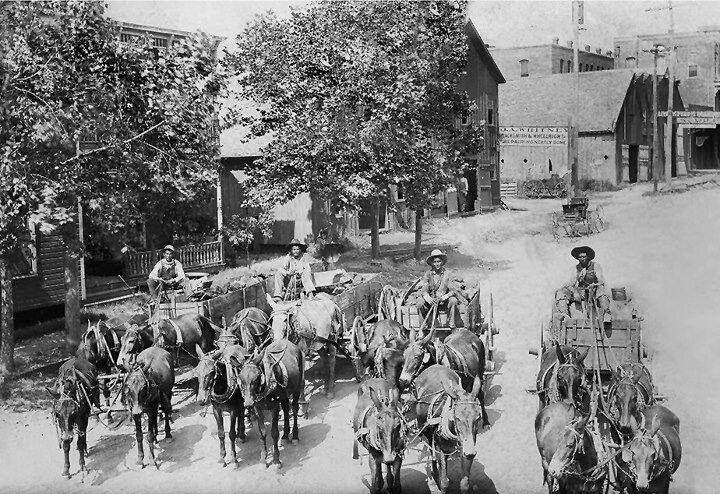|
Natal Native Pioneer Corps
The Natal Native Pioneer Corps, commonly referred to as the Natal Pioneers, was a British unit of the Zulu War. Raised in November/December 1878 the unit served throughout the war of 1879 to provide engineering support to the British invasion of Zululand. Three companies were formed each comprising around 100 men and clad in old British Army uniforms. The units served at the battles of Isandlwana, Eshowe and Ulundi. Background The British High Commissioner for Southern Africa Sir Henry Bartle Frere had been attempting to form a confederation of British possessions in Southern Africa. As part of this ambition the annexation of Zululand was planned, this led to the Anglo-Zulu War of 1879. As part of preparations for this war the British military commander Frederic Thesiger (later and more commonly known as Lord Chelmsford) began gathering forces in the Colony of Natal for an invasion of Zululand. Chelmsford's plan called for an invasion by five columns of troops, though manpower ... [...More Info...] [...Related Items...] OR: [Wikipedia] [Google] [Baidu] |
Pioneer (military)
A pioneer () is a soldier employed to perform engineering and construction tasks. The term is in principle similar to sapper or combat engineer. Pioneers were originally part of the artillery branch of European armies. Subsequently, they formed part of the engineering branch, the logistic branch, part of the infantry, or even comprised a branch in their own right. Historically, the primary role of pioneer units was to assist other arms in tasks such as the construction of field fortifications, military camps, bridges and roads. Prior to and during the First World War, pioneers were often engaged in the construction and repair of military railways. During World War II, pioneer units were used extensively by all major forces, both on the front line and in supporting roles. During the 20th century, British Commonwealth military forces came to distinguish between small units of " assault pioneers" belonging to infantry regiments and separate pioneer units (as in the former Royal Pi ... [...More Info...] [...Related Items...] OR: [Wikipedia] [Google] [Baidu] |
Natal Native Contingent
The Natal Native Contingent was a large force of auxiliary soldiers in British South Africa, forming a substantial portion of the defence forces of the British colony of Natal. The Contingent saw action during the 1879 Anglo-Zulu War. The Natal Mounted Police was created in 1873 to bolster the defenses of Natal. It enlisted European officers, NCOs and natives. The infantry was created in 1878. Most enlisted troops were drawn from the Basuto and Mpondo tribes, which had had long experience fighting the Zulus. Establishment and organisation The Natal legislature established the Natal Mounted Police in 1873 and appointed Major J. G. Dartnell as commander. However, they were slow to appropriate funds for the organization. The first trooper enrolled in March 1874. The first headquarters were at Fort Napier in Pietermaritzburg. The infantry was created in 1878 under Lieutenant-Colonel Anthony William Durnford as part of the Zululand expeditionary force. The structure of the NNC ... [...More Info...] [...Related Items...] OR: [Wikipedia] [Google] [Baidu] |
Military Units And Formations Disestablished In 1879
A military, also known collectively as armed forces, is a heavily armed, highly organized force primarily intended for warfare. It is typically authorized and maintained by a sovereign state, with its members identifiable by their distinct military uniform. It may consist of one or more military branches such as an army, navy, air force, space force, marines, or coast guard. The main task of the military is usually defined as defence of the state and its interests against external armed threats. In broad usage, the terms ''armed forces'' and ''military'' are often treated as synonymous, although in technical usage a distinction is sometimes made in which a country's armed forces may include both its military and other paramilitary forces. There are various forms of irregular military forces, not belonging to a recognized state; though they share many attributes with regular military forces, they are less often referred to as simply ''military''. A nation's military may ... [...More Info...] [...Related Items...] OR: [Wikipedia] [Google] [Baidu] |
House Of Commons
The House of Commons is the name for the elected lower house of the bicameral parliaments of the United Kingdom and Canada. In both of these countries, the Commons holds much more legislative power than the nominally upper house of parliament. The leader of the majority party in the House of Commons by convention becomes the prime minister. Other parliaments have also had a lower house called a "House of Commons". History and naming The House of Commons of the Kingdom of England evolved from an undivided parliament to serve as the voice of the tax-paying subjects of the counties and of the boroughs. Knights of the shire, elected from each county, were usually landowners, while the borough members were often from the merchant classes. These members represented subjects of the Crown who were not Lords Temporal or Spiritual, who themselves sat in the House of Lords. The House of Commons gained its name because it represented communities (''communes''). Since the 19th cen ... [...More Info...] [...Related Items...] OR: [Wikipedia] [Google] [Baidu] |
Buffs (East Kent Regiment)
The Buffs (Royal East Kent Regiment), formerly the 3rd Regiment of Foot, was a line infantry regiment of the British Army traditionally raised in the English county of Kent and garrisoned at Canterbury. It had a history dating back to 1572 and was one of the oldest regiments in the British Army, being third in order of precedence (ranked as the 3rd Regiment of the line). The regiment provided distinguished service over a period of almost four hundred years accumulating one hundred and sixteen battle honours. In 1881, under the Childers Reforms, it was known as the Buffs (East Kent Regiment) and later, on 3 June 1935, was renamed the Buffs (Royal East Kent Regiment). In 1961, it was amalgamated with the Queen's Own Royal West Kent Regiment to form the Queen's Own Buffs, The Royal Kent Regiment, which was later merged, on 31 December 1966, with the Queen's Royal Surrey Regiment, the Royal Sussex Regiment and the Middlesex Regiment (Duke of Cambridge's Own) to form the Queen's Regi ... [...More Info...] [...Related Items...] OR: [Wikipedia] [Google] [Baidu] |
Wagons Crossing Amatikulu Drift On The Way To Eshowe
A wagon or waggon is a heavy four-wheeled vehicle pulled by draught animals or on occasion by humans, used for transporting goods, commodities, agricultural materials, supplies and sometimes people. Wagons are immediately distinguished from carts (which have two wheels) and from lighter four-wheeled vehicles primarily for carrying people, such as carriages. Animals such as horses, mules, or oxen usually pull wagons. One animal or several, often in pairs or teams may pull wagons. However, there are examples of human-propelled wagons, such as mining corfs. A wagon was formerly called a wain and one who builds or repairs wagons is a wainwright. More specifically, a wain is a type of horse- or oxen-drawn, load-carrying vehicle, used for agricultural purposes rather than transporting people. A wagon or cart, usually four-wheeled; for example, a haywain, normally has four wheels, but the term has now acquired slightly poetical connotations, so is not always used with techni ... [...More Info...] [...Related Items...] OR: [Wikipedia] [Google] [Baidu] |
The Burning Of Ulundi
''The'' () is a grammatical article in English, denoting persons or things that are already or about to be mentioned, under discussion, implied or otherwise presumed familiar to listeners, readers, or speakers. It is the definite article in English. ''The'' is the most frequently used word in the English language; studies and analyses of texts have found it to account for seven percent of all printed English-language words. It is derived from gendered articles in Old English which combined in Middle English and now has a single form used with nouns of any gender. The word can be used with both singular and plural nouns, and with a noun that starts with any letter. This is different from many other languages, which have different forms of the definite article for different genders or numbers. Pronunciation In most dialects, "the" is pronounced as (with the voiced dental fricative followed by a schwa) when followed by a consonant sound, and as (homophone of the archaic ... [...More Info...] [...Related Items...] OR: [Wikipedia] [Google] [Baidu] |
Isandlwana
Isandlwana () (older spelling ''Isandhlwana'', also sometimes seen as ''Isandula'') is an isolated hill in the KwaZulu-Natal province of South Africa. It is located north by northwest of Durban. The name is said to mean abomasum, the second stomach of the cow, because it reminded the Zulus of its shape. History This mountain has historical significance. On 22 January 1879, Isandlwana was the site of the Battle of Isandlwana, where approximately 22,000 Zulu warriors defeated a contingent of approximately 1,750 British and African troops in one of the first engagements of the Anglo-Zulu War. The Zulu force was primarily under the command of Ntshingwayo kaMahole Khoza. The battle was one of the worst defeats suffered by the British Army during the Victorian era In the history of the United Kingdom and the British Empire, the Victorian era was the period of Queen Victoria's reign, from 20 June 1837 until her death on 22 January 1901. The era followed the Georgian p ... [...More Info...] [...Related Items...] OR: [Wikipedia] [Google] [Baidu] |
Corduroy Road
A corduroy road or log road is a type of road or timber trackway made by placing logs, perpendicular to the direction of the road over a low or swampy area. The result is an improvement over impassable mud or dirt roads, yet rough in the best of conditions and a hazard to horses due to shifting loose logs. Corduroy roads can also be built as a foundation for other surfacing. If the logs are buried in wet, acidic, anaerobic soils such as peat or muskeg, they decay very slowly. A few corduroy road foundations that date back to the early 20th century still exist in North America. One example is the Alaska Highway between Burwash Landing and Koidern, Yukon, Canada, which was rebuilt in 1943, less than a year after the original route was graded on thin soil and vegetation over permafrost, by using corduroy, then building a gravel road on top. During the 1980s, the gravel was covered with a chip-seal. The late 1990s saw replacement of this road with modern road construction, ... [...More Info...] [...Related Items...] OR: [Wikipedia] [Google] [Baidu] |
Rorke's Drift
The Battle of Rorke's Drift (1879), also known as the Defence of Rorke's Drift, was an engagement in the Anglo-Zulu War. The successful British defence of the mission station of Rorke's Drift, under the command of Lieutenants John Chard of the Royal Engineers and Gonville Bromhead, 24th Regiment of Foot began when a large contingent of Zulu warriors broke off from their main force during the final hour of the British defeat at the day-long Battle of Isandlwana on 22 January 1879, diverting to attack Rorke's Drift later that day and continuing into the following day. Just over 150 British and colonial troops defended the station against attacks by 3,000 to 4,000 Zulu warriors. The massive but piecemeal attacks by the Zulu on Rorke's Drift came very close to defeating the much smaller garrison, but were consistently repelled. Eleven Victoria Crosses were awarded among the defenders, along with a number of other decorations and honours. Prelude Rorke's Drift, known as ''kwaJ ... [...More Info...] [...Related Items...] OR: [Wikipedia] [Google] [Baidu] |
Buffalo River (KwaZulu-Natal)
The Buffalo River ( zu, uMzinyathi; af, Buffelsrivier) is the largest tributary of the Tugela River in South Africa. With a total length of , its source is in Majuba Hill, "Hill of Doves" in Zulu language, located northeast of Volksrust, close to the Mpumalanga / KwaZulu-Natal border. It follows a southerly route into KwaZulu-Natal past Newcastle then turns southeast past Rorke's Drift, before joining the Tugela River at Ngubevu near Nkandla. During the nineteenth century it formed part of the boundary between the Colony of Natal and Zululand. The Buffalo River has a number of tributaries, including the Ingagane from the SW and the Blood River from the NE, which it joins near Kandi Mountain. Rorke's Drift is a ford across the Buffalo River which is one of the famous places of the 1878-79 Anglo-Zulu War and Isandhlwana is another important place of that war located about 20 km SE of the river, not far from the confluence with the Tugela. Tributaries * Batshe * ... [...More Info...] [...Related Items...] OR: [Wikipedia] [Google] [Baidu] |




.png)

